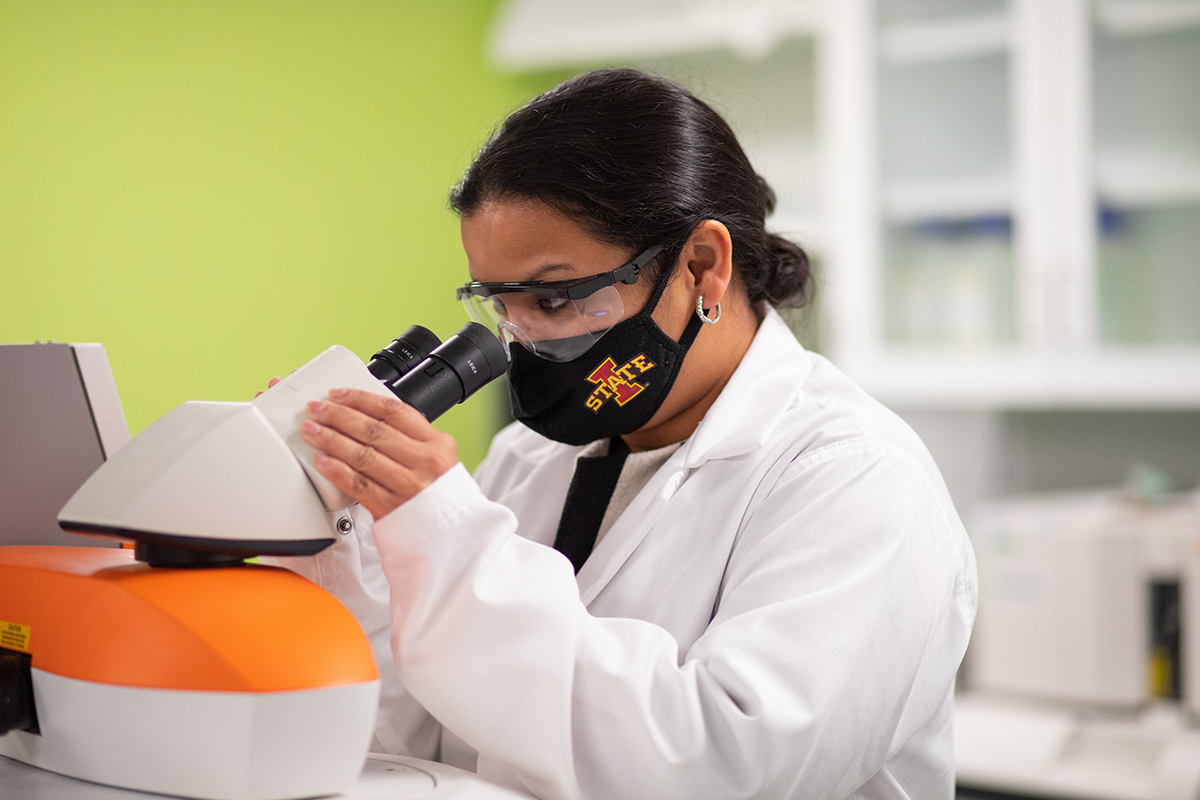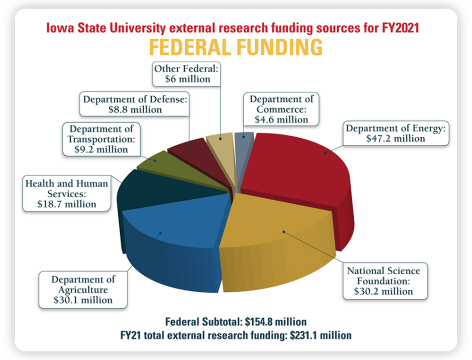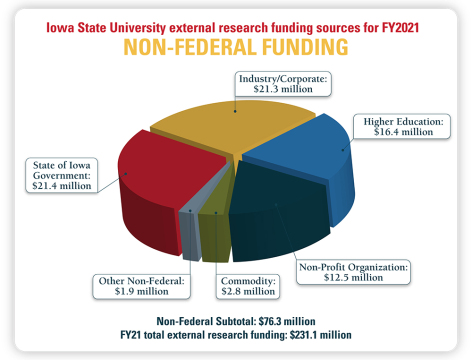
Rizia Bardhan uses a Raman spectrometer in her lab at Iowa State's Nanovaccine Institute. Bardhan is using technology to enhance individualized treatment for colorectal cancer. Larger photo. Photo by Christopher Gannon.
AMES, Iowa – Iowa State University attracted $559.1 million in external funding for the fiscal year that ended June 30, breaking the previous record of $509.2 million set in fiscal year 2018.
The fiscal year 2021 total includes $231.1 million in sponsored research funding, including $154.8 million from federal sources. The total also includes $90.2 million in federal COVID-19 Higher Education Emergency Relief Funding.
This is the third time in the past five fiscal years that Iowa State's external funding total has passed $500 million. Fiscal year 2020’s total of $494.7 million nearly crossed that threshold.
Even through the challenges of a pandemic, Iowa State researchers “stayed committed to relevance and purpose, whether it’s unearthing answers to larger questions through fundamental research, or applied research that translates to new innovations that can be commercialized to grow our economy and benefit our society,” said Peter Dorhout, the vice president for research.
Here are just a few of the research projects winning support this year:
- The Agriculture and Rural Communities (ARA) Wireless Living Lab for Smart and Connected Rural Communities recently won a five-year grant of $16 million – $7 million from the National Science Foundation (NSF), $1 million from the U.S. Department of Agriculture’s National Institute of Food and Agriculture (NIFA) and $8 million of in-kind support from industry partners. The project will test and develop affordable, high-capacity rural broadband technology. It's part of the national Platforms for Advanced Wireless Research (PAWR) program and is led by Hongwei Zhang, a professor of electrical and computer engineering.
- A project called COALESCE has won a five-year, $7 million Cyber-Physical Systems Frontier award jointly funded by NSF and the USDA's NIFA. Researchers are applying layers of technologies – including sensors, machine learning, artificial intelligence, small robots and drones – that could allow farmers to fertilize, weed and cull single plants in a field, rather than relying on broad measures such as heavy machinery and broadcast spraying. The project is led by Soumik Sarkar, the Walter W. Wilson Faculty Fellow in Engineering and an associate professor of mechanical engineering.
- With more than $900,000 in grants from the U.S. Department of Health and Human Services, the Centers for Disease Control and Prevention and the National Institutes of Health, Iowa State researchers are using their expertise in graphene-based biosensors to develop better, cheaper, quicker and more accessible testing for the coronavirus that causes COVID-19. The project is led by Carmen Gomes and Jonathan Claussen, associate professors of mechanical engineering.
- A grant of nearly $590,000 from the U.S. Army Medical Research Acquisition Activity is supporting studies of 3D systems and spectroscopy screening to enhance individualized treatment for colorectal cancer. The project is led by Rizia Bardhan, an associate professor of chemical and biological engineering.
In addition to grants supporting research teams across campus, external funding also provides academic support, scholarships and more. The funding can include contracts, gifts and cooperative agreements from federal, state and local governments, as well as from corporations, nonprofits and other universities.
---
Recent history of external funding totals
- FY21, $559.1 million
- FY20, $494.7 million
- FY19, $469 million
- FY18, $509.2 million
- FY17, $503.6 million
- FY16, $425.8 million
- FY15, $424.9 million
- FY14, $368.4 million
- FY13, $326.4 million
- FY12, $360.2 million
- FY11, $342.3 million
- FY10, $388.2 million
Contacts
Peter Dorhout, Vice President for Research, 515-294-1785, dorhout@iastate.edu
Dan Kirkpatrick, Office of the Vice President for Research, 515-294-6257, dank@iastate.edu
Mike Krapfl, News Service, 515-294-4917, mkrapfl@iastate.edu
Quote
Iowa State researchers “stayed committed to relevance and purpose, whether it’s unearthing answers to larger questions through fundamental research, or applied research that translates to new innovations that can be commercialized to grow our economy and benefit our society."
Peter Dorhout, vice president for research
Quick look
Iowa State University attracted a record $559.1 million in external funding for fiscal year 2021, including $231.1 million in sponsored research funding and $90.2 million in federal COVID-19 relief funding. Research projects winning support last fiscal year included studies of rural broadband, ultra-precision agriculture, coronavirus testing and technology for individualized cancer treatments.
Research notes
The Office of the Vice President for Research has analyzed Iowa State's external research funding.

